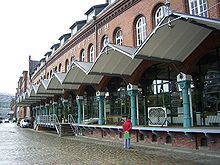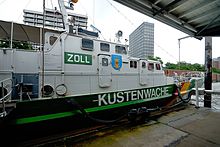German Customs Museum
 Logo of the German Customs Museum |
|
| Data | |
|---|---|
| place | Hamburg |
| Art | |
| opening | 1992 |
| Number of visitors (annually) | 118,000 as of 2001 |
| operator |
Federal Ministry of Finance
|
| Website | |
| ISIL | DE-MUS-079318 |
The German Customs Museum is the national customs museum about the past and present of customs. It is located on the site of the former Hamburg customs office .
history
The German Customs Museum is the successor to the Reichszollmuseum in Berlin, which was destroyed in the Second World War . The customs museum was created, among other things, from the exhibits in the customs museum in the former customs criminal investigation institute in Cologne. This Cologne museum was closed after the exhibits were handed over to the German Customs Museum. In 2015, the German Customs Museum also took over the collection of the former tax museum in Brühl near Cologne. The collection of the customs museum in Hamburg was also integrated, the founder of which is the former customs officer Werner Fox († January 22, 2016), who also published on the history of the water customs service .
The museum was opened in 1992 in the former Kornhausbrücke customs office in Hamburg's historic warehouse district . The permanent exhibition was modernized between 2006 and 2008. In 2001 the customs museum had 118,000 visitors.
Collection and exhibition
The customs museum shows around 1,000 objects on 800 square meters of exhibition space. The (reference) library of the German Customs Museum is said to be the most extensive collection in Germany with 6,000 books on customs history from antiquity to modern times.
Buildings and outdoor areas
The building of the customs museum was built in 1900 and is located on the customs canal right next to the Kornhausbrücke. Until 1984, the Kornhausbrücke customs office was used for import customs clearance for carpets.
In front of the museum is a floating terminal building from an abandoned Hamburg customs office. The toll cruiser Glückstadt could be viewed there as a museum ship until summer 2005 . After it was scrapped, it was replaced by the Oldenburg .
Ground floor: Customs today
The ground floor is dedicated to today's customs and its areas of responsibility. The "borderless" customs in the European Union , social justice, world trade , product piracy , species protection , weapons and drugs as well as various consumption taxes are discussed and, among other things, confiscated objects and smuggling hiding spots are presented. Most of the exhibits, such as old uniforms and technical aids, were privately collected by customs officers and prepared for presentation.
First floor: Customs earlier
The upper floor in the exhibition building is dedicated to the customs of earlier times, from the Roman provinces to the time of the Federal Customs Administration and Customs Administration of the GDR . Exhibits from different epochs, the Middle Ages, the time of small German states, the founding time of the German Customs Union and the German Empire from 1871, the Weimar Republic , the Third Reich and the division of Germany , illustrate the history of customs.
literature
- German Customs Museum, Christian Schaade (Ed.): German Customs Museum. A tour of the exhibition. Exhibition catalog. German Customs Museum, Hamburg 2017.
Web links
- German Customs Museum
- Museum library at the State and University Library Hamburg
Individual evidence
- ↑ Peer Steinbrück opens the German Customs Museum . In: Hamburger Abendblatt , September 22, 2008, accessed on March 27, 2018.
- ↑ Speicherstadt - The attractions . In: Hamburger Abendblatt, February 19, 2002, p. 15.
- ^ Federal Ministry of Finance - Department III: German Customs Museum. Leaflet, Bonn, January 2011 online .
- ^ Matthias Gretzschel: From the Corpus Delicti to the museum piece . In: Hamburger Abendblatt, September 1, 1994, p. 10. (Part X of the series Private Museums in Hamburg )
- ↑ On the trail of smugglers in the customs museum . In: NDR , May 22, 2017, accessed on March 27, 2018.
- ↑ Hunting wooden elephants and garden gnomes . In: Der Spiegel , August 3, 2001, accessed on March 27, 2018.
Coordinates: 53 ° 32 ′ 46 ″ N , 9 ° 59 ′ 57 ″ E


